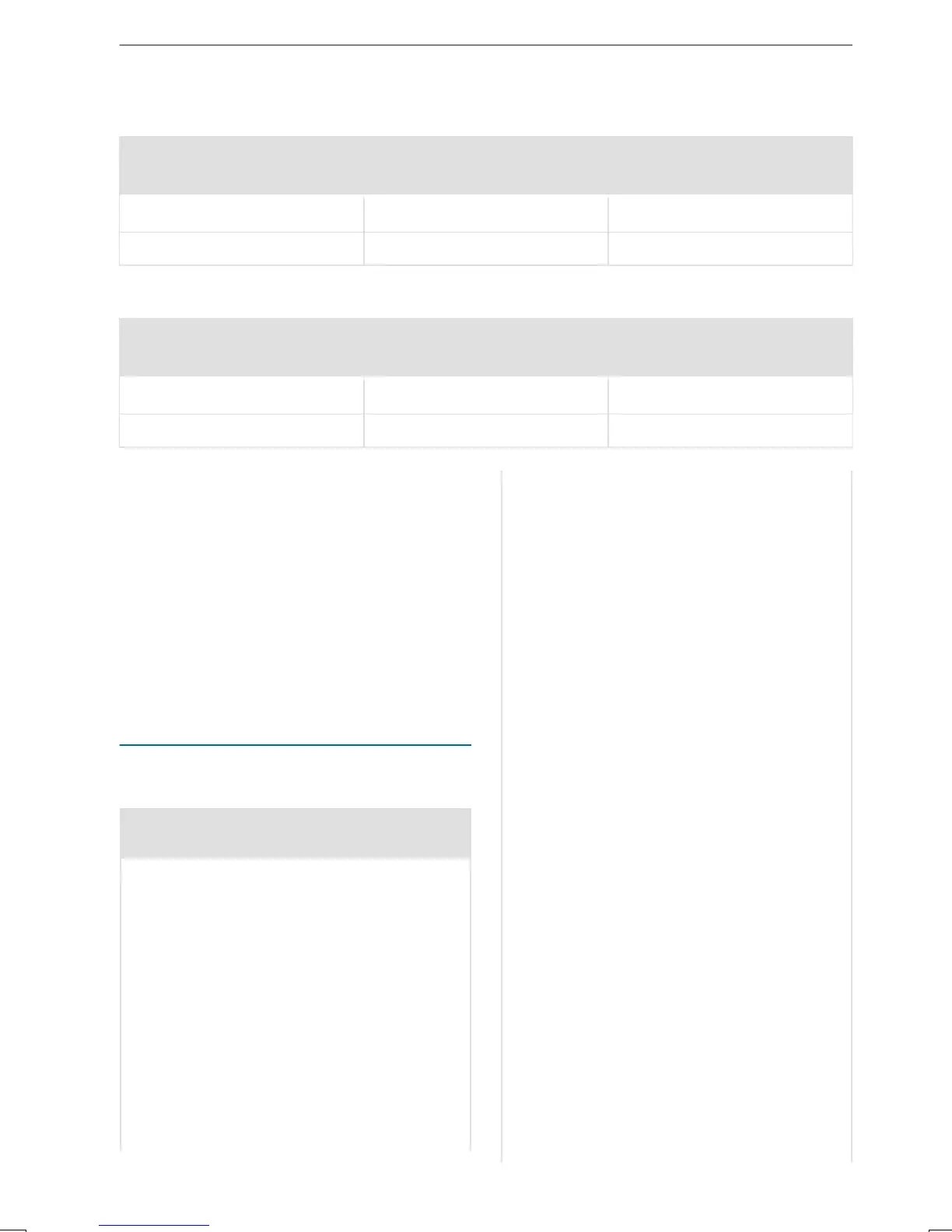Rear axle tirepressures on vehicles with rear wheel driveand Super Single tires
Max. rear axle load 7055 lbs (3200 kg)
Tires/disc wheel Vehicleload Max. rear axle load
7055 lbs (3200 kg)
225/75R16C 121/120R (122L) Fullyladen
690 kPa(6.9bar/100 psi)
3)
285/65R16C 131R Fully laden 460 kPa(4.6bar/67psi)
Max.rear axleload 7716 lbs (3500 kg)
Tires/disc wheel Vehicleload Max. rear axle load
7716 lbs (3500 kg)
225/75R16C 121/120R (122L) Fullyladen
690 kPa(6.9bar/100 psi)
3)
285/65R16C 131R Fully laden 520 kPa(5.2bar/75psi)
3)
Valid to use forashorttime as asparewheel
on therear axle foramaximumdistance of
62 miles (100 km) and amaximum speed of
34 mph(55 km/h).
Be suretoalso observethe following further rela‐
tedsubjects:
R
Notesontirepressure(/page296)
R
Tire and LoadingInformationplacard
(/ page302)
R
Maximum tirepressure(/page307)
Tire pressuremonitor
Function of tirepressuremonitor on single
tires
&
DANGER Risk of accidentdue to incor‐
rect tirepressure
Everytire, including thespare(if provided),
should be checkedwhen cold at leastoncea
monthand inflated to thepressurerecom‐
mended by thevehicle manufacturer (see Tire
and LoadingInformationplacardonthe B-pil‐
lar on thedriver’sside or thetirepressure
label on theinside of thefuel filler flap of your
vehicle). If your vehicle has tires of adifferent
size than thesize indicated on theTireand
Loading Informationplacardorthe tirepres‐
suretable, youneedtodetermine theproper
tirepressurefor those tires.
As an added safetyfeature, your vehicle has
been equipped withatirepressuremonitor‐
ing system (TPMS) that illuminates alow tire
pressureindicator lampwhen one or moreof
your tires aresignificantlyunderinflated.
Accordingly,ifthe lowtirepressureindicator
lamplights up, youshouldstopand check
your tires as soon as possible, and inflate
them to theproper pressure. Driving on asig‐
nificantly underinflatedtirecauses thetireto
overheat and can lead to tirefailure. Underin‐
flationalso increases fuel consumption and
reduces tiretread life, and mayaffect the
vehicle's handling and braking ability.Please
note that theTPMS is notasubstitutefor
proper tiremaintenance, and it is thedriver's
responsibility to maintain correct tirepres‐
sure, evenifunderinflation hasnot reached
theleveltotrigger illumination of theTPMS
lowtirepressureindicator lamp.
Your vehicle has also been equipped witha
TPMS malfunction indicator to indicatewhen
thesystemisnot operating properly.The
TPMSmalfunction indicator is combined with
thelow tirepressureindicator lamp. When
thesystemdetects amalfunction, theindica‐
torlampwillflash forapproximately aminute
and then remain continuously illuminated.
This sequence will continue upon subsequent
vehicle start-ups as longasthe malfunction
exists.
When themalfunction indicator is illuminated,
thesystemmay notbeable to detect or sig‐
nal lowtirepressure as intended. TPMS mal‐
functionsmay occur foravariety of reasons,
includingthe installation of incompatible
300
Wheels and tires

